



The nucleus of No.838 Squadron assembled at RNAS Eastleigh, Hampshire, on April 10th 1942, under the command of Lt. Cdr J. R. C. Callandar RN and sailed in the troopship BANFORA for Halifax, Nova Scotia, where they disembarked to RN Air Section Dartmouth, which lodged on the Royal Canadian Air Force station of the saame name, on May 15th. The squadron officially formed on this date as a Torpedo Bomber Reconnaissance squadron for service in an escort carrier with four Swordfish I aircraft issued from the Dartmouth storage section. The next two and a half months were spent working-up; during this period two of the original four aircraft were lost, both in June; on the 2nd an unidentified Swordfish is recorded as wrecked, on the 21st the CO made a forced landing in the sea in Swordfish V4317.
The squadron was allocated for service in
HMS ATTACKER, the first 'Bogue' class escort carrier to be supplied under the Lend-Lease agreement; she was completing her fitting out at the Mare Island Naval Shipyard, Vallejo California and was expected to be commissioned by the start of October 1942. The squadron was to join her at San Francisco to work-up with the ship; plans were made to fly cross-country, departing from Dartmouth early in the morning on July 30th. The CO plus three pilots, 1 navigator and what maintenance personnel could be carried as passengers set of on a seven and a half day journey which was undertaken in 15 stages:
Halifax to Bangor, Maine; Bangor to Montreal; Montreal to Kingston, Ontario (overnight stay); Kingston to Selfridge Field, Detroit; Detroit to Battle Creek, Michigan; Michigan to Chicago (overnight stay); Chicago to Des Moines (got lost landed at Moline, Illinois); Moline to Omaha (overnight stay,); Omaha to North Platte, Nebraska; North Platte to Cheyenne, Wyoming; Cheyenne to Rock Springs, Wyoming; Rock Springs to Salt Lake City, Utah (overnight stay,); Salt Lake City to Elko, Nevada: Elko to Reno, Nevada (overnight stay,); Reno to Alameda, San Francisco. A total of thirty-five and a half hours flying time from Halifax.
The four aircraft landed at USNAS Alameda Island on August 6th 1942 and began preparations for joining the ship. The remainder of the squadron personnel arrived later by train. Their carrier, US designation ACV- 7 was delivered to the US Navy and commissioned as USS BARNES on September 30th 1942; she was decommissioned and transferred to the Royal Navy on the same day, commissioning as HMS ATTACKER.
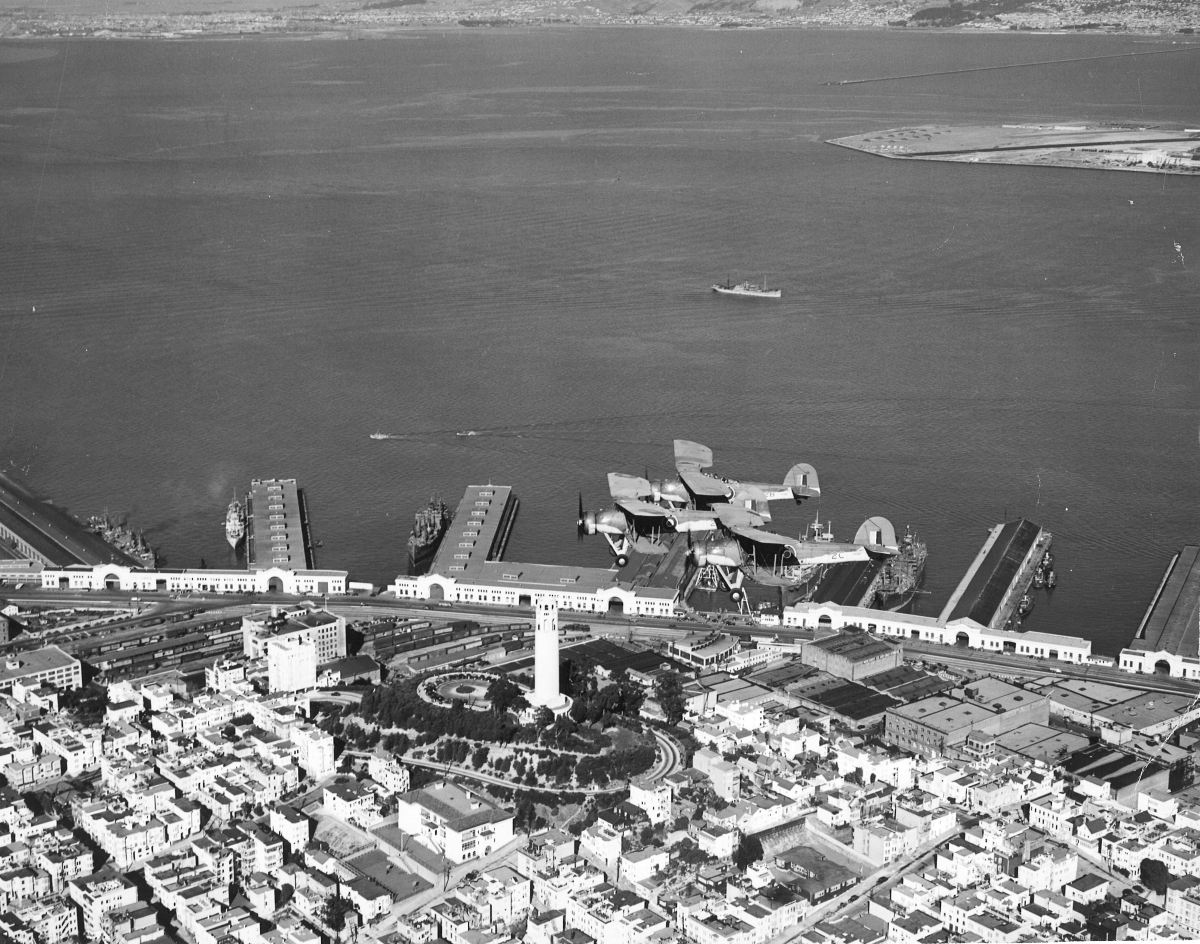
3 of the 4 Swordfish aircraft of 838 naval air squadron operating from USNAS Alemeda Island, flying over San Francisco. Photo courtesy of Dan Shumaker
The ship began sea and flying trials off San Francisco on November 12th, embarking 838 squadron aircraft from USNAS Alemeda Island on December 12th. On completion of her trials and shake down she sailed from San Francisco for Balboa on December 12th and passed through the Panama Canal to arrive at Cristobal on December 22nd 1942. From Cristobal she headed for the US Naval operating Base at Norfolk, Virginia. On arrival 838 squadron was disembarked to USNAS Quonset Point on January 1st 1943. Another Swordfish squadron, 840 was already there waiting to join ATTACKER. During January and February 1943 ATTACKER underwent defect rectification and the installation of equipment in Norfolk, as well as spending a period of flying training in Chesapeake Bay with Martlet fighters from 882, 896 and 898 squadrons and Swordfish from 838 and 840 squadrons which were working up at USNAS Quonset Point.
On March 2nd 838 squadron re-embarked together with a further 4 Swordfish of 840 squadron, both flying out from USNAS Quonset Point, to provide air cover for an eastbound convoy from Curacao. The ship called at Kingston Jamaica on route and two replacement Swordfish (V4718 & W3967) were embarked from the storage section at RNAS Palisadoes. At least one aircraft suffered significant damage while flying from the ship, V4387 ('2C') lost its undercarriage when it missed all the arrestor wires and was stopped by the barrier; date and location are unknown.
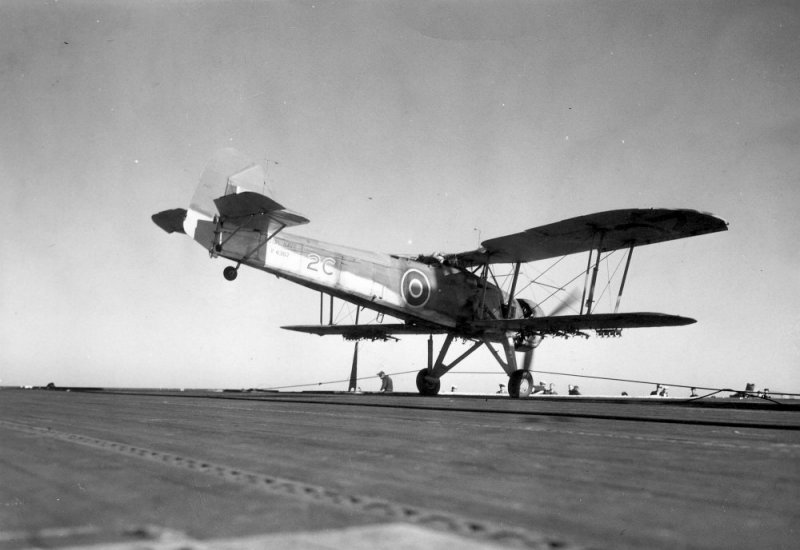
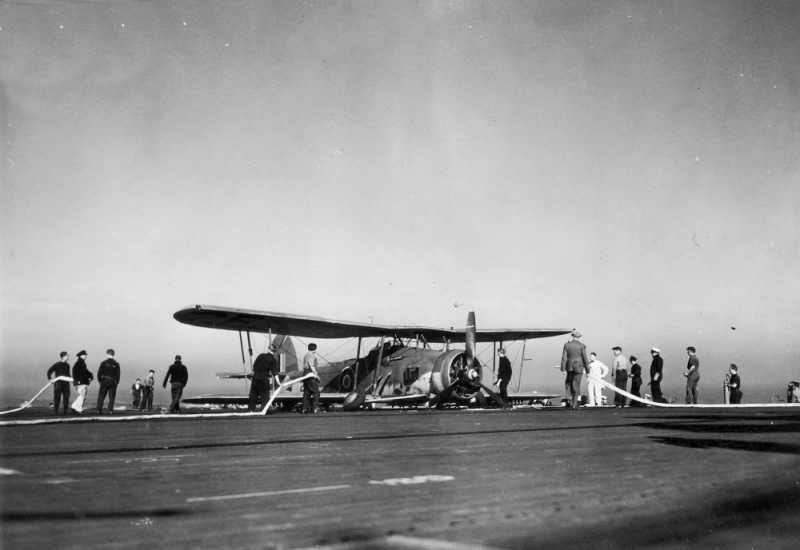
At RNAS Machrihanish the squadron was reallocated for MAC-ship service; the Mk I Swordfish were withdrawn and new Mk II machines were received. On June 7th Lt. (A) R.G Large RNVR assumed command, the squadron moved to RNAS Maydown, Northern Ireland on June 13th. The pilots and aircraft flew out to the training carrier HMS ARGUS on July 9th for a day of DLT, before they embarked in the British built escort carrier HMS ACTIVITY on July 18th for a work up and intensive period of DLT before disembarking to RNAS Belfast on the 30th.
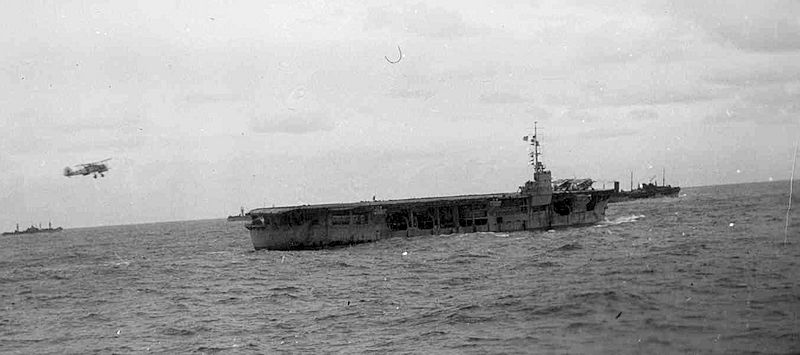
Swordfish coming into to land on a Rapana class merchant aircraft carrier after a patrol escorting an Atlantic convoy. The other three aircraft are parked in the bow, there was no hangar on these makeshift carriers. Photo Ref:VR997.011.2 courtesy of CFB Esquimalt Naval & Military Museum
The squadron embarked in the MAC-ship MV RAPANA on August 2nd for trials but owing to a change of policy, the squadron merged into No. 836 Squadron on August 13th 1943 as 'L' Flight: 836 squadron were responsible for all MAC ship flights and was based at RNAS Maydown.
On November 1st 1943, No.838 reformed at RNAS Belfast from part of No.818 Squadron as a torpedo bomber reconnaissance squadron with 4 Swordfish Ils, Lt. Cdr (A) J.M. Brown DSC RNVR in command. On December 17th they embarked in HMS NAIRANA for working up in the Clyde, disembarking to RNAS Dunino on January 16th J 1944. A further move was made to RNAS Inskip on February 6th where it increased to 9 aircraft on the 14th. They moved again to RNAS Machrihanish on March 18th, and increased to 12 aircraft, a mix of ASV Mk.XI equipped Swordfish Ils and Ills, on April 1st.
On April 20th 1944 No. 838 moved south to join No. 156 GR Wing, RAF Coastal Command at RAF Station Harrowbeer for anti-submarine operations in the English Channel during the build-up to the Normandy invasion.
On the night of April 30th 1944 a flight of three aircraft were tasked with making an RP strike on a beached German Elbing-class destroyer (probably T-27) at Vierge, Brittany [1]. Swordfish NE906 ('F') crewed by Sub- Lt I. L. R. Wilson, RNZNVR, Sub- Lt E. T. Clark RNVR & P.O. A. C. Rockley; NE923 ('G'), crewed by Sub- Lt L. F. Hayward, RNZNVR, Sub- Lt DJ Hanson, RNVR & Ldg Airman B. L. Rowntree; and NE946 ('K') crewed by Sub- Lt S. F. Such, RNVR, Lt J. B. Cook, RNVR & P.O. R. C. Grapes took off to make the strike. The beached German destroyer was not defenceless however, its anti-aircraft weapons shot down NE906 and NE923, both crashed in France, while Swordfish NE946 was hit by fire from coastal AA batteries and ditched in the sea; all nine crew were killed. It transpired that aircraft from 838 were not meant to undertake this operation; an RAF Typhoon squadron was the intended unit but orders were sent to 838 instead.
Once the invasion bridgehead had been established he squadron withdrew to Northern Ireland; calling at RNAS Worthy Down on August 8th and then RAF Long Kesh on the 9th to regroup. Lt. Cdr P. Snow RN assumed command on August 19th 1944 and the squadron arrived at RNAS Maydown on the 27th.
In September they re-joined Coastal Command in Scotland, flying to RAF Long Kesh on the 10th on route to RAF Benbecula where they arrived on the 12th. Further moves were made to RAF Dallachy on the 28th, and RAF Fraserburgh on October 22nd. A fighter flight was formed at RNAS Eglinton on October 27th equipped with four Wildcat Vls, but this was transferred to No.856 Squadron at the end of November.
No. 838 moved for a final time to RAF Thorney Island on November 15th
1944,;theey disbanded there on February 3rd 1945.
Content revised: 23 October 2022
Additional sources:
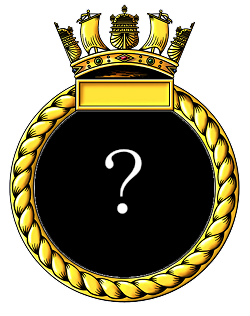
Atlantic 1943
Normandy 1944
Swordfish I May 42 -Apr 43
Swordfish II Apr 1943 - Aug 43
Swordfish II Nov 1943 - Feb 45
Swordfish III May 44 - Feb 45
Wildcat VI Oct 44 - Nov 44
Lt. Cdr J. R. C. Callandar RN 15 May 42
Lt. (A) R. G. Large RNVR 7 Jun 43
Squadron disbanded 13 Aug 43
Lt. Cdr (A) J. M. Brown DSC RNVR 1 Nov 43
Lt. Cdr P. Snow RN 19 Aug 1944
Squadron disbanded 03 Feb 1945
None
© 1999-2025 The Royal Navy Research Archive All Rights Reserved Terms of use Powered byW3.CSS
Press F5 to refresh the page after posting your comment or to hide the form
Note
T27 ran aground, en route to L'Aber Vrac'h for repairs after an
action against Force 26 on the night of 28/29 April 1944. She was
finally destroyed by British MTBs on 6 May after several
unsuccessful air attacks. See
https://en.wikipedia.org/wiki/Elbing-class_torpedo_boat
Comments (2)
I would like, being in touch with several relatives of the shot down Swordfishes, to correct several things, as several things Ray Sturvivant wrote about it in his book are wrong.
12 a/c took off, not 3.
Target was finally M156 minewheeper, not T27.
Place wasn’t Ile Vierge, which is outside Aber Wrac’h, but in the harbour, face to Landéda.
At low tide the boat was on its side, not standing right. From a local account, I also know it was once reversed on the other side using cables fitted to winches positioned on the road near the abbey, but when this was done is and should stay a mistery.
At the time of the attack, around 00h30 french (german) hour, the tide was high (as can be proved today via our local “SHOM” website, but I do wonder if any of the M156 guns were still usable that night, as the boat also previously suffered several Typhoons attacks and had received several shells earlier in February when it came to the harbour for repair.
Sub-Lt ET Clark RNVR.I was born in 1949 so I never knew my Uncle, My Father Lt Cmdr J.S.Clark was Wards twin brother that was his family nickname his correct name was Edward Thomas. My Grandfather Lt Cmdr E.S.Clark was a Headmaster in the RN. My late father & Ward where born in Plymouth on the 21st October 1920 so they where destined to be in the Navy, Our father served on HMS Vanguard on the Royal Tour of South Africa in 1947 Soon after he suffered from mental health problems thought to be a delayed reaction to Wards death,He spent years trying to find out the exact details of his brothers death without success,I was disgusted when I found out that the 838 Squadron crew sent on this mission where given the wrong orders all 9 young men died because of this,The person who gave the wrong orders was promptly posted to another Base.